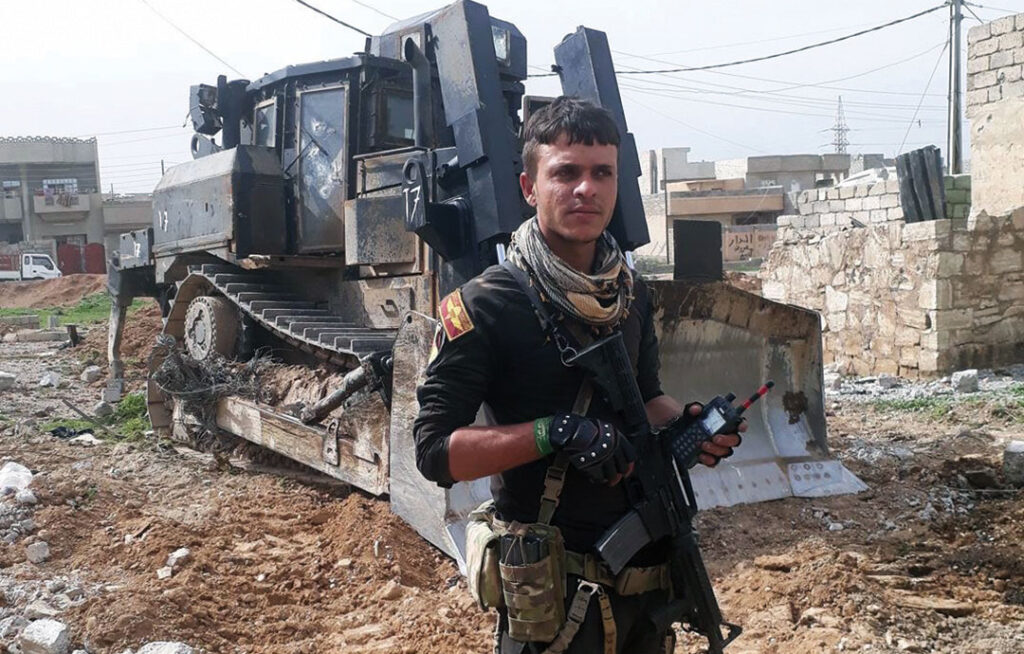Iraqi military forces enlisted bulldozers to overwhelm terrorists in the streets of Mosul
UNIPATH STAFF
During the battles to liberate Iraqi cities from Daesh, one particular hero preferred to work from the shadows, assuming the role of an unknown Soldier. Yet this hero spearheaded advancing columns, repelled terrorist car bombs, and plowed through their barricades. His presence sowed terror in the hearts of the enemy, shaking their morale as he breached their defensive positions. This hero is Chief Warrant Officer Mohammed Ali Abdullah of the Iraqi Counter Terrorism Service, and his weapon of choice was a 29-ton hulk of steel called the D7R-II bulldozer.
Built in the United States by Caterpillar, the bulldozer, equipped with heavy armor and bullet-resistant glass, approached the weight of a Bradley Fighting Vehicle. Its powerful engine was able to overcome most obstacles Daesh threw in its path.
The use of bulldozers was a tribute to Iraqi military ingenuity, resourceful troops using whatever material was at hand to defeat a determined enemy. Chief Warrant Officer Mohammed said the tactic of using bulldozers to advance in front of tanks and ground troops was imposed upon Iraqi forces by the necessities of asymmetric warfare, particularly in the clutter of urban streets.
Daesh terrorists popularized the use of car bombs driven by suicide bombers to attack Iraqi troops. Among the bulldozer’s most critical duties was blocking such cars before they could approach Iraqi convoys.
“The terrorists severed most roads with obstacles like abandoned cars, leaving open only roads they controlled with the aim of deploying car bombs to halt the movement of convoys and then swooping in from neighboring houses to destroy the force,” Chief Warrant Officer Mohammed said.
“It became impossible to advance any military convoy without a bulldozer at the forefront. The role of bulldozers was distinct during the battles of Mosul; it was our weapon of choice to destroy the enemy’s defenses, disable and destroy vehicle-borne improvised explosive devices and clear obstructions from roads.”
Coalition forces equipped the Counter Terrorism Service with these tactical bulldozers in 2016 and sent experts to train operators and technicians in driving and maintaining the machines. Up to that point, Iraqi forces had used lighter weight commercial bulldozers that had suffered heavy losses from enemy ambushes.
“We were trained to advance the bulldozer in an urban warfare environment by specialists from the coalition forces. The training included learning about the techniques and capabilities of the bulldozer,” Chief Warrant Officer Mohammed said.
“For several months before we participated in the battles, we conducted exercises in a terrain that simulated the nature of the battlefield. The bulldozer was introduced during the battle for Mosul in 2016.”
The bulldozer became part of the military’s plan to liberate cities from Daesh. The operator needed to react quickly and clear paths for Iraqi forces before enemy fighters could launch ambushes in the rubble- and car-choked streets of Mosul.
Chief Warrant Officer Mohammed recalls the time he intercepted a car bomb before it reached the armored vehicle transporting his commander. The place was West Mosul. The date was May 27, 2017. Mohammed’s unit was assigned to protect the advance of the Muthanna Counterterrorism Battalion, led by Lt. Col. Thaer Saadoun Munshid.
“The bulldozer was subjected to several sniper attacks and improvised explosive devices without stopping, and I was relying on the covering fire of my comrades in the convoy. Daesh bullets hit the windshield glass, causing a terrifying sound and smashing part of the glass, but I was used to hearing that sound,” Mohammed said.
During his preoccupation with clearing the main roads for his comrades, Mohammed got a call on his radio from one of his superior officers. A vehicle-borne improvised explosive device (VBIED) was approaching their column from the right, set on a destructive collision course.
Mohammed had to act fast. He spotted the car bomb 100 meters away. He yanked the controls of the bulldozer. The metal beast lunged 90 degrees and plowed forward on an intercept course with the car bomber. As he angled the bulldozer between the would-be bomber and his commander’s Humvee, the bomb detonated.
“I felt the heat of the explosion, and the flash of the big bang shook my cabin,” he said. “Nothing was between the VBIED and me but a few feet, the thick glass and the steel of the bulldozer’s plating. The explosion was so severe that the front windshield glass was completely shattered. Yet it absorbed the shock and saved me from harm.”
Despite the blast, the bulldozer suffered little damage. Repair crews needed only to patch some leaks in its hydraulic pipes to get it moving again.
In a short time, Chief Warrant Officer Mohammed — and the brave troops of the Counter Terrorism Service — were rolling forward again, rolling forward to victory. F

